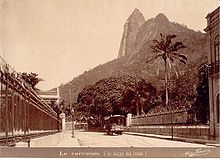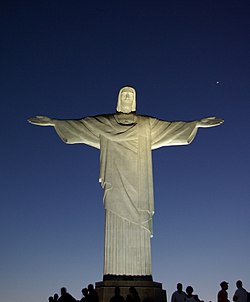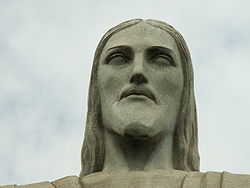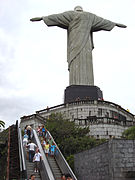Christ the Redeemer (statue)
For other statues with this name, see Christ the Redeemer (disambiguation).
| Christ the Redeemer | |
|---|---|
 | |
| Coordinates | 22°57′7″S 43°12′38″WCoordinates: 22°57′7″S 43°12′38″W |
| Location | Rio de Janeiro, Brazil |
| Designer | Created by French sculptor Paul Landowski and built by the engineer Heitor da Silva Costa Brazil in collaboration with the French engineer Albert Caquot. |
| Material | Soapstone |
| Height | 30 metres (98 ft) and 38 metres (125 ft) tall with its pedestal |
| Completion date | Dedicated October 12, 1931 |
| Consecrated October 12, 2006 New Seven Wonders of the World July 7, 2007 | |
Christ the Redeemer (Portuguese: Cristo Redentor, standard Brazilian Portuguese: [ˈkɾistu ʁedẽˈtoʁ], local dialect: [ˈkɾiʃtu ɦedẽjˈtoɦ]) is an Art Deco statue of Jesus Christ in Rio de Janeiro, Brazil, created by French sculptor Paul Landowski and built by the Brazilian engineer Heitor da Silva Costa, in collaboration with the French engineer Albert Caquot. It is 30 metres (98 ft) tall, not including its 8-metre (26 ft) pedestal, and its arms stretch 28 metres (92 ft) wide.[1]
The statue weighs 635 metric tons (625 long, 700 short tons), and is located at the peak of the 700-metre (2,300 ft) Corcovado mountain in the Tijuca Forest National Park overlooking the city of Rio. As a symbol of Brazilian Christianity, the statue has become an icon for Rio de Janeiro and Brazil.[2] It is made of reinforced concrete and soapstone, and was constructed between 1922 and 1931
History[edit]
The idea of building a large statue atop Corcovado was first suggested in the mid-1850s, when Vincentian priest, Pedro Maria Boss, suggested placing a Christian monument on Mount Corcovado to honour Princess Isabel, princess regent of Brazil and the daughter of Emperor Pedro II, although the project was never approved.[1] In 1889, the country became a republic and, with the official separation of state and church, the idea was dismissed.[6]
The second proposal for a landmark statue on the mountain was made in 1920, by the Catholic Circle of Rio.[7] The group organized an event called Semana do Monumento("Monument Week") to attract donations and collect signatures to support the building of the statue. The donations came mostly from Brazilian Catholics.[3] The designs considered for the "Statue of the Christ" included a representation of the Christian cross, a statue of Jesus with a globe in his hands, and a pedestal symbolizing the world.[8] The statue of Christ the Redeemer with open arms, a symbol of peace, was chosen.
Local engineer Heitor da Silva Costa designed the statue; it was sculpted by Polish-French sculptor Paul Landowski.[9]
The face of the statue was created by Romanian sculptor Gheorghe Leonida, who was born in Galati, Romania, in 1893. He studied sculpture at the Fine Arts Conservatory in Bucharest, then, after three more years' study in Italy, he won a prize for the sculpture Reveil ("Awakening"). After that he moved to Paris, where his work, Le Diable ("The Devil"), was awarded the Grand Prix. Becoming famous in France as portraitist, he was included by Paul Landowski in the team that started working on Christ the Redeemer in 1922. Gheorghe Leonida contributed by portraying Jesus Christ's face on the statue, which made him famous.[10]
A group of engineers and technicians studied Landowski's submissions and the decision was made to build the structure out of reinforced concrete (designed by Albert Caquot) instead of steel, more suitable for the cross-shaped statue. The outer layers are soapstone, chosen for its enduring qualities and ease of use.[4] Construction took nine years, from 1922 to 1931 and cost the equivalent ofUS$250,000 ($3,300,000 in 2015). The monument was opened on October 12, 1931.[4][5] During the opening ceremony, the statue was lit by a battery of floodlights turned on remotely by shortwave radio pioneer Guglielmo Marconi, stationed 5,700 miles (9,200 km) away in Rome.[7]
In October 2006, on the 75th anniversary of the statue's completion, Archbishop of Rio, Cardinal Eusebio Oscar Scheid, consecrated a chapel, named after Brazil's patron saint—Our Lady of the Apparition, under the statue. This allows Catholics to hold baptisms and weddings there.[5]
The statue was struck by lightning during a violent thunderstorm on February 10, 2008, and suffered some damage to the fingers, head and eyebrows. A restoration effort was put in place by the Rio de Janeiro state government to replace some of the outer soapstone layers and repair the lightning rods installed on the statue. It was damaged by lightning again, on January 17, 2014, where a finger on the right hand was dislodged.[11][12][13][14]
In 2010, a massive restoration of the statue was undertaken. The statue was washed, the mortar and soapstone that cover the statue were replaced, the internal structure of iron was restored, and the monument was made waterproof. The statue was vandalized during renovation, wherein paint was sprayed along the arm. Mayor Eduardo Paes called the act "a crime against the nation". The culprits later apologised and presented themselves to the police.[15][16][17]
Restoration[edit]
In 1990, restoration work was conducted through an agreement among several organizations, including the Archdiocese of Rio de Janeiro, media company Rede Globo, oil company Shell do Brasil, environmental regulatorIBAMA, National Institute of Historic and Artistic Heritage, and the city government of Rio de Janeiro.
More work on the statue and its environs was conducted in 2003 and early 2010. In 2003, a set of escalators, walkways, and elevators were installed to facilitate access to the platform surrounding the statue. The four-month restoration in 2010[18] focused on the statue itself. The statue's internal structure was renovated and its soapstone mosaic covering was restored by removing a crust of fungi and other microorganisms and repairing small cracks. The lightning rods located in the statue’s head and arms were also repaired, and new lighting fixtures were installed at the foot of the statue.[19]
The restoration involved one hundred people and used more than 60,000 pieces of stone taken from the same quarry as the original statue.[18] During the unveiling of the restored statue, it was illuminated with green-and-yellow lighting in support of the Brazil national football team playing in the 2010 FIFA World Cup.[18]
Maintenance work needs to be conducted periodically due to the strong winds and erosion to which the statue is exposed, as well as lightning strikes.[20] The original pale stone is no longer available in sufficient quantities, and replacement stones are increasingly darker in hue.[21]
See also[edit]
- Monumento al Divino Salvador del Mundo, Monument to the Savior of the World San Salvador City, El Salvador
- Cristo Redentore, Christ the Redeemer of Maratea, Italy
- Christ of Vung Tau in Vietnam (32 m)
- Christ Blessing in Manado, North Sulawesi, Indonesia (30 m)
- Jesus Christ Statue[22] in Mansinam Island, West Papua, Indonesia (30 m)
- Cristo-Rei in Lisbon, Portugal (28 m)
- Cristo Rei of Dili: a 27 metre high statue in Dili, Timor-Leste
- Cerro del Cubilete in Guanajuato, Mexico: a 23 metre high statue inspired by Christ the Redeemer
- Christ of the Ozarks in Arkansas, United States: a 20 metre high statue inspired by Christ the Redeemer
- Christ of Havana in Havana, Cuba: a 20 metre high statue inspired by Christ the Redeemer
- Christ the Redeemer of the Andes (Argentina/Chile)
- Cristo de la Concordia in Cochabamba, Bolivia
- Cristo de las Noas in Torreón, Mexico
- Christ of the Abyss in various underwater locations
- Christ the King (Polish: Pomnik Chrystusa Króla), 33 metres (108 ft) tall and weighing 440 tonnes, in Świebodzin, Poland
- Cristo del Pacífico, Lima, Peru, a 37 metre high statue erected in 2011
- Christ the Sacred Heart of Jesus, Ibiza, Spain: a 23 metre high statue inspired by Christ the Redeemer
- Statue of Jesus Christ on the top of Sagrat Cor, Barcelona, Spain
- List of statues by height
Gallery[edit]
|











Nice Blog. Kindly check my travel blog on Christ the Redeemer.
ReplyDelete